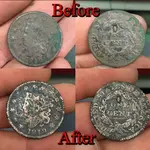I posted this last year on the forum, not sure if Jeff saved it or not, but anyway here is my procedure again. I must stress, I have been doing it for several years now and started on a lot of buttons first, but what convinced me it was good when my son did it on his super rare 1785 Vermont Immune Columbia coin which we thought was toast and it came out more recognizable once cleaned with the Peroxide.
Some Coppers just cannot be cleaned and not lose detail for the simple fact the corrosion has already damaged the coin beyond hope and for those who say the cleaning lost the detail are correct, except it was the deterioration of the coin from corrosion that did it, the cleaning just took away that corrorsion.
OK, nuf said on that, here are the procedures:
Directions for the Cleaning of Artifacts/Coins using Hydrogen PeroxideRequired items:
1 - Disposable plastic bowl – I use an empty margarine container
ADDED: - I now use a harder plastic container that can go into the microwave
1 - Bottle of Hydrogen Peroxide which is 3% H2O2
1 - Heat Source – I have a gooseneck lamp with a halogen bulb in it.
1 - Box of Cotton Swabs – Q Tips are the best – others fall apart too easily
Make sure the artifact/coin is free of any oil coating like olive oil if you previously had soaked this object. The oil coating prevents the Hydrogen Peroxide from working on the dirt.
Put object to be cleaned in disposable plastic bowl and then pour Hydrogen Peroxide on top until it is at least a half an inch above the object to be cleaned.
Using the lamp as a heater, I position the lamp to within 2-4 inches of the bowl. This heats up the solution. Be careful not to cause anything to melt from too much heat, use common sense for this part. A Heat Source is NOT necessary, but it does speed up the cleaning significantly...
ADDED: YOU CAN USE A MICROWAVE TO HEAT THE PEROXIDE UP FIRST, BUT BE CAREFULL AND PLEASE USE A SAFE CONTAINER WITH NO METAL IN IT, PUT THE RELIC/COIN IN AFTER THE HEAT UP IN THE MICROWAVE!!!!!
If the solution is hot enough the boiling of the Peroxide should be very evident to you and should remind you of a geyser. Once it is cooking it sprays the bubbles and smokes a little also. This should continue for anywhere from one hour to two or three.
Periodically remove the object if you want to check on the progress. I usually then lay it on a napkin and take a cotton swab and start to gently rub and see how much crud is coming off the object. It might take several hours or more to get real clean. You might even have to repeat the entire process if the object has a lot of stubborn crud on it.
When the bubbling of the Peroxide stops the cleaning also is done. If it needs more cleaning start over again with fresh fluid.
Keep your cotton swabs wet with the Peroxide while gently rubbing, this will prevent scratches.
When done with your cleaning, rinse the object well with water.
The first coin I did with this method did not require any rubbing whatsoever. I believe each artifact/coin is unique in how it is cleaned. Some did not clean up hardly at all. If it is a corroded object, like a pitted, green Indian Head, I don’t think anything you do will help that.
My best advice is to experiment on non-valuable objects first and then move on to your better finds once you build confidence in what you are doing.
The objects may appear dried out after cleaning, if you want you can coat with a coin preservative like Blue Ribbon Coin Conditioner and Preservative or a similar product or even a light coating of Vaseline.
Don in South Jersey




